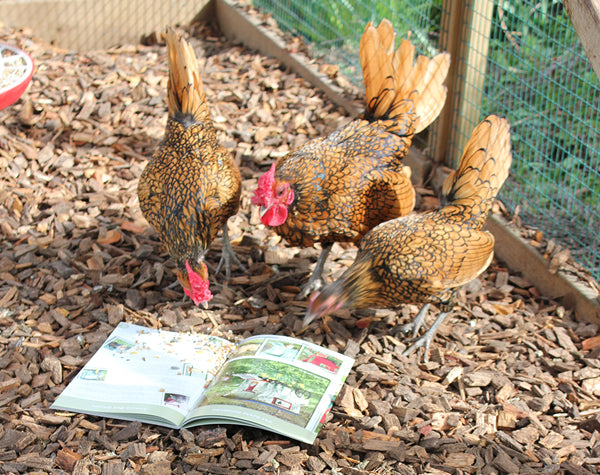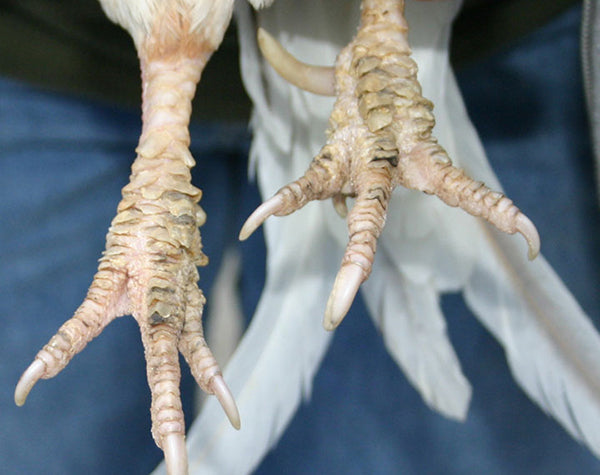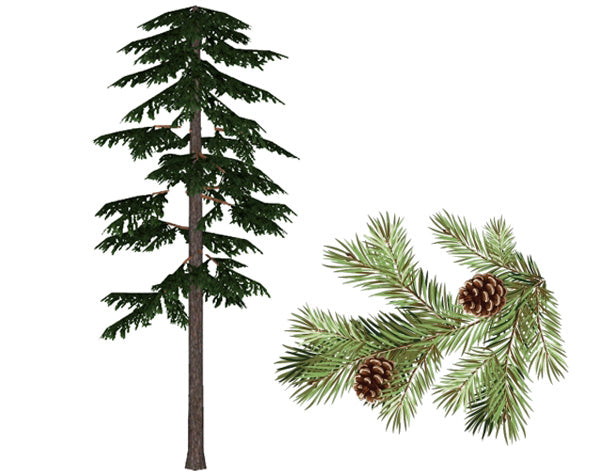Feather Pecking among Chickens

It is fair to say that it isn't always love, harmony and affection in the chicken coop - here we hope to help you identify and cure any chicken coop scuffles.
To some people, chickens are just those brown feathered things that lay the eggs you keep in the fridge. To others (the special, initiated, fans of chickens) they are a constant source of enjoyment and as much a member of the family as any other pet.
However, whatever your view on chickens, they have become embedded in the very lexicon of our language. If you are in a small space you feel 'cooped up'. Perhaps your 'chickens will be coming home to roost' because you have 'chickened out' and are now 'running around like a headless chicken'.
Possibly the most pervading phrase though has to be 'the pecking order'. From the Houses of Parliament to Poultry Houses there are pecking orders. However, only in the latter case does any literal pecking occur (well ... ...)
Identifying Feather Pecking
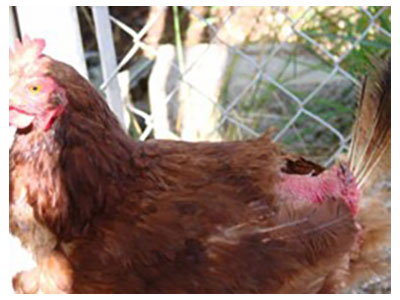
Chickens will always peck at each other a little bit, this is almost an essential part of establishing a 'pecking order', or hierarchy, amongst the flock. So the 'top hen' will peck at others and the lowest bird in the order will be pecked most.
Most of the time this isn't a real problem. You'll probably find that the bird at the bottom of the social order will merely high-tail it away if it gets fed up and no real damage is done. However, if your hens are kept in an enclosed run, simply running away might not be an option.
Feather pecking is, as the name suggests, when one hen starts pecking at another's feathers and pulls them out causing distress to the birds and, in some cases, drawing blood from a wound.
Open wounds can lead to cannibalism and therefore needs immediate attention. This is not to be confused with an over-amorous cockerel who can often pull feathers out of a hen's back and neck while trying to gain a perch or when feathers fall out during the annual moult.
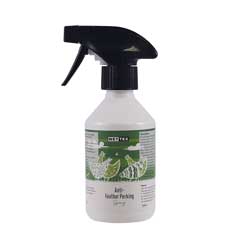
Pecking often occurs around the hen's vent, back or head. A good indication that this is occurring is not only bald patches on the birds but the sign of half-eaten feathers around the coop. Anti-Pecking Sprays are the most popular answer to this problem.
Chickens are attracted to the colour red (one reason why so many poultry feeders and drinkers are red) so the comb, wattle and the vent - which is often reddened after laying an egg - draws the attention of other hens.
Chickens are attracted to blood, the colour and smell (they are after all essentially mini dinosaurs). Therefore, if wounds are left untreated, it will only attract them more.
Always make sure you treat any blood or wounds straight away with either a Gentian Violet spray or an Antibacterial Wound Powder, for the well-being of the bird.
Preventing Boredom among Chickens
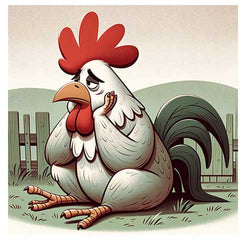
This is number one on the list. If your hens have to be kept in an enclosed space (for their safety or your sanity) then perhaps this is the easiest to solve.
Convention says that a hen needs 3 sq. ft. of outdoor space when permanently enclosed in a run.
You might find giving your birds that extra bit of space, if possible, will solve the problem.
Equally, like all living things, chickens like to feel the sun on their backs and it provides essential Vitamin D (but they will still need shade options too).

If you have them tucked away in a dark and dingy corner of the garden, can you move them so that they can enjoy more daylight?
Having sufficient daylight is good for their health and calming, and will help them lay more, and better, eggs.
If neither of these is an option for you, giving the birds something to occupy themselves is one way to cure boredom.
Hanging Boredom Buster Chicken Treats or perhaps a few fresh greens hung around the run will help keep your hens distracted and busy.
Do your hens have a nice friable surface to scratch around in during the day to look for bugs and worms e.g. Hardwood Woodchip?
Can you give them some stimulation, like perches in their run perhaps, an activity centre, or old tree branches to stand on?
Stressed Chickens leading to Feather Pecking
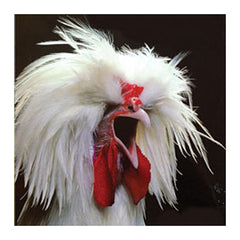 Stress is also sometimes a reason for aggressive feather pecking. A chicken coop that is too hot in summer will stress the birds, try to increase the ventilation to cure this problem.
Stress is also sometimes a reason for aggressive feather pecking. A chicken coop that is too hot in summer will stress the birds, try to increase the ventilation to cure this problem.
If you have too many hens in one hen house or poultry run, the lack of space will stress them. Can you reduce the overcrowding?
As a guide, a hen should be allowed 1 to 2 sq ft in their house with 7in - 8in of perch space to roost on.
When laying an egg especially, chickens like the area to be cosy, dark and quiet. Excessive or glaring lights will only stress them and reduce egg-laying. A chicken coop should have at least one nest space per 4 to 5 birds.

Anti-Feather Pecking Sprays can help to break a feather pecking habit but it is trial and error until you find one that works best. The spray is applied to the victim bird, it creates a foul taste in the perpetrator's mouth, helping to deter them from pecking.
Some pecking sprays are clear liquids and contain antiseptics, whilst others are brown and based on Stockholm Tar which is an old traditional method to stop pecking or biting.
You may find one type will work with your flock whilst another may not so you may need some trial and error to find the right one.
The Annual Moult
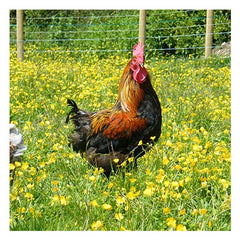
Both Cockerels and hens moult. For laying hens the moult is a yearly process, usually around the end of summer and the start of autumn.
This is when a chicken replaces its feathers over a period of approximately one to two months, sometimes longer.
The moult can begin, surprisingly, as late as December in some birds. Cockerels equally moult annually so they can regrow beautiful plumage ready for their mating period in the Spring.
Whilst hens are moulting they will not be laying eggs either and this gives their bodies a rest from the rigours of producing an egg almost every day. As their feathers regrow and the combs become red again, they will come back into lay.
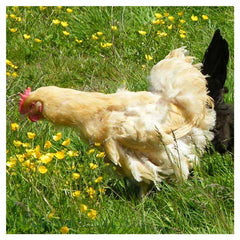
They will look really bedraggled and 'under the weather' during this time, and therefore enticing to other hens, who will peck at the newly emerging quills and the area of reddened skin. This can quickly escalate to cannibalism so should be dealt with straight away.
Gentian Violet Spray will work as both an antiseptic and will colour the affected area purple.
As chickens are attracted to the red skin of a pecked bird, turning the skin purple is an easy solution to helping the poor bird.
An anti-feather pecking spray would help in this instance also, making the newly emerging quills taste bad to the pecking hens.
To help your birds through the yearly moult they need extra protein and calcium. This will aid feather regrowth, and add some calcium for their bones and egg shells. A good all-round tonic or extra protein feed may be necessary.
Try changing their diet to a poultry growers pellet for a month or so to give them that little bit extra. Look for a feed with a protein level of around 18% or give a high protein treat.

The moult is an exhausting time for all poultry so give them a boost with a tonic in their drinking water. Life-Guard Poultry Tonic is rich in vitamins A and D it helps with the general conditioning of your bird, especially useful around the moult.
Other tips are to give them high protein treats - Natures Grub Superfoods Treat - that will encourage speedy growth of feathers. Verm-X Poultry Zest Pellets is another option to add to feed so their bodies can recover quickly.
Lack of protein in the hens diet
A lack of protein in the diet is perhaps a less frequent reason for feather pecking, but it is a consideration if you see your birds pulling out and eating the feathers but you don't feel that this is being done in an aggressive manner.
Feathers are made of protein, so if a bird's body feels it is suffering from this deficiency, it can turn to eating feathers as a source of this much-needed macronutrient.

Making sure that your hens have a good, balanced diet, in particular a quality layers pellet as their staple feed will help keep this to a minimum.
Their Layers Pellets should contain around 14%-16% protein, this will be on the label e.g. the Smallholder Layers Pellets range, or try the very popular Garvo Alfamix for Chickens.
Until the 2014 introduction of an EU regulation which said that we can no longer sell (market) mealworms as being 'for chickens', dried mealworms would have been suggested as a good source of protein, as they are a high protein food.
However, although your choice of feed is up to you, we cannot recommend these any longer so they are now only available in our wild bird feed section, Dried Mealworms for Birds.
Persistent Peckers!

If you have a persistent pecking problem and none of the above solves it, then the answer might be segregation or isolation.
Remove either the bird who is doing the pecking (ideally) or the bird who is being pecked, to give her time to recover and grow new feathers safely.
This option does depend on whether you have one aggressor and several victims or one victim and several aggressors. Therefore the decision of which to remove is dependent on that.
When a bird is segregated it should still be located near the other hens, where it can be seen by the remaining flock. This is an important point. While hens can still see each other, they remain part of the same flock, even if separated.
Perhaps you can create a separate run area, for example, a freestanding run within their current Pen, or place one beside it, so the birds can still see one another, this can often break the habit.
If you completely remove the hen (victim), out of sight, and then try to re-introduce her, you might find feather pecking starts all over again as they will bully the 'new' member of the flock. Therefore it may be best to take out the aggressor.
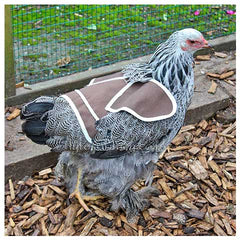
When separating the culprit from the flock, leave them apart from the others for around a week at least. Hopefully, by then, they will have forgotten their aggressive behaviour.
However, if separating the birds is simply not an option for you, or hasn't worked, perhaps consider putting a poultry saddle on the victim (before you ask, no, this kind of saddle doesn't have stirrups!).
A Canvas Saddle should protect the hen's back and shoulders allowing feathers to regrow underneath, as well as preventing wounds made by other aggressive birds.
Further help
We hope you found this article useful and for a video of our 5 Top Tips to Tackle Feather Loss in Chickens visit our #Ask Phill Video No 13 where Phill describes the reasons for most feather loss and also the solutions.
If you have any questions about products for dealing with feather pecking or ways to soothe and help the afflicted birds, please Email Us or call our team on 01300 345229.
- - - -
Feather Pecking Amongst Chickens ©Flyte so Fancy 2009. Updated 2023. Author: Anne Weymouth (Co-Founder and Co-Director, Flyte so Fancy Ltd). Reproduction of part or all of this text is only possible with the express permission of Flyte so Fancy Ltd.

